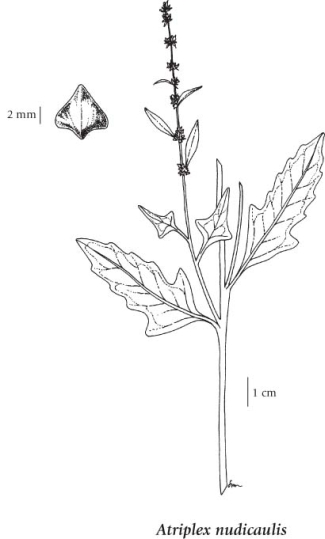Atriplex longipes Drejer
long-stalked orache
Amaranthaceae (Amaranth family)
(Previously in Chenopodiaceae)
Introduction to Vascular Plants
long-stalked orache
Amaranthaceae (Amaranth family)
(Previously in Chenopodiaceae)
Introduction to Vascular Plants
Species Information
General:
Annual herb from a taproot; stems procumbent to erect, several, branched, 30-90 cm tall/long.
Leaves:
Lower leaves alternate, lanceolate to diamond-shaped, with basal lobes, entire to shallowly toothed, green; upper leaves green above and below.
Flowers:
Inflorescence of terminal or axillary spikes or panicles; smaller bracteoles triangular, fused at the base, green, 5-10 mm long; larger bracteoles triangular, leafy at the tip, 2.5-3.0 cm long, some of these with stalks 5-20 mm long.
Fruits:
Membranous pericarps; seeds erect.
Illustration

If more than one illustration is available for a species (e.g., separate illustrations were provided for two subspecies) then links to the separate images will be provided below. Note that individual subspecies or varietal illustrations are not always available.
Illustration Source: The Illustrated Flora of British Columbia
Habitat and Range
Moist to mesic marine shorelines in the lowland zone; rare in SW BC, known only from Surrey and White Rock; introduced from Eurasia.Status Information
| Origin Status | Provincial Status | BC List (Red Blue List) | COSEWIC |
|---|---|---|---|
| Exotic | SNA (2019) | Exotic | Not Listed |
BC Ministry of Environment: BC Species and Ecosystems Explorer.
Synonyms
Synonyms and Alternate Names:
Atriplex nudicaulis Boguslaw
Taxonomic Notes
"The genus Atriplex, commonly called orache, atriplex or saltbush, of the family Chenopodiaceae (the goosefoot family), comprises nearly 200 species. The genus has a worldwide distribution, occurring on all continents except Antarctica. Most of the species are halophytes of coastal or inland saline habitats; a few are widespread ruderals of disturbed ground." (Bassett et al. 1983).
References Bassett, I. J., C. W. Crompton, J. McNeill and P. M. Taschereau. 1983. The genus Atriplex (Chenopodiaceae) in Canada. Monograph #31, Agriculture Canada, Ottawa. |